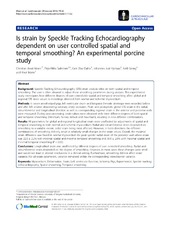| dc.contributor.author | Moen, Christian A. | en_US |
| dc.contributor.author | Salminen, Pirjo-Riitta | en_US |
| dc.contributor.author | Dahle, Geir O. | en_US |
| dc.contributor.author | Hjertaas, Johannes Just | en_US |
| dc.contributor.author | Grong, Ketil | en_US |
| dc.contributor.author | Matre, Knut | en_US |
| dc.date.accessioned | 2013-11-12T14:24:01Z | |
| dc.date.available | 2013-11-12T14:24:01Z | |
| dc.date.issued | 2013-08-22 | eng |
| dc.identifier.issn | 1476-7120 | |
| dc.identifier.uri | https://hdl.handle.net/1956/7524 | |
| dc.description.abstract | Background Speckle Tracking Echocardiography (STE) strain analysis relies on both spatial and temporal smoothing. The user is often allowed to adjust these smoothing parameters during analysis. This experimental study investigates how different degrees of user controllable spatial and temporal smoothing affect global and regional STE strain values in recordings obtained from normal and ischemic myocardium. Methods In seven anesthetized pigs, left ventricular short- and long-axis B-mode cineloops were recorded before and after left anterior descending coronary artery occlusion. Peak- and postsystolic global STE strain in the radial, circumferential and longitudinal direction as well as corresponding regional strain in the anterior and posterior walls were measured. During post-processing, strain values were obtained with three different degrees of both spatial and temporal smoothing (minimum, factory default and maximum), resulting in nine different combinations. Results All parameters for global and regional longitudinal strain were unaffected by adjustments of spatial and temporal smoothing in both normal and ischemic myocardium. Radial and circumferential strain depended on smoothing to a variable extent, radial strain being most affected. However, in both directions the different combinations of smoothing did only result in relatively small changes in the strain values. Overall, the maximal strain difference was found in normal myocardium for peak systolic radial strain of the posterior wall where strain was 22.0 ± 2.2% with minimal spatial and maximal temporal smoothing and 30.9 ± 2.6% with maximal spatial and minimal temporal smoothing (P < 0.05). Conclusions Longitudinal strain was unaffected by different degrees of user controlled smoothing. Radial and circumferential strain depended on the degree of smoothing. However, in most cases these changes were small and would not lead to altered conclusions in a clinical setting. Furthermore, smoothing did not affect strain variance. For all strain parameters, variance remained within the corresponding interobserver variance. | en_US |
| dc.language.iso | eng | eng |
| dc.publisher | BMC | eng |
| dc.rights | Attribution CC BY | eng |
| dc.rights.uri | http://creativecommons.org/licenses/by/2.0 | eng |
| dc.subject | Myocardium | eng |
| dc.subject | Deformation | eng |
| dc.subject | Strain | eng |
| dc.subject | Left ventricular function | eng |
| dc.subject | Ischemia | eng |
| dc.subject | Pigs | eng |
| dc.subject | Experimental | eng |
| dc.subject | Speckle tracking echocardiography | eng |
| dc.subject | Spatial smoothing | eng |
| dc.subject | Temporal smoothing | eng |
| dc.title | Is strain by Speckle Tracking Echocardiography dependent on user controlled spatial and temporal smoothing? An experimental porcine study | en_US |
| dc.type | Peer reviewed | |
| dc.type | Journal article | |
| dc.date.updated | 2013-10-06T04:10:51Z | |
| dc.description.version | publishedVersion | en_US |
| dc.rights.holder | Copyright 2013 Moen et al.; licensee BioMed Central Ltd. | |
| dc.source.articlenumber | 32 | |
| dc.identifier.doi | https://doi.org/10.1186/1476-7120-11-32 | |
| dc.identifier.cristin | 1062130 | |
| dc.source.journal | Cardiovascular Ultrasound | |
| dc.identifier.citation | Cardiovascular Ultrasound. 2013, 11, 32. | |
| dc.source.volume | 11 | |

